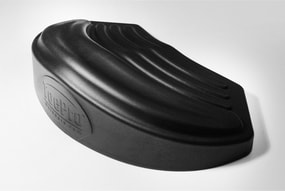|
The patented ToePro strengthening device facilities the most effective and simple method of improving foot muscle strength, can be used for effective eccentric calf exercises, promotes ankle flexibility and assists in strengthening synergists of the triceps surae complex. This device paves the way for practitioners now to focus on improving ankle flexibility and promoting strengthening of the muscles of the foot. This can potentially reduce and redistribute loads away from the plantar fascia and potentially improve strength for the outside stabilizers of the ankle. These are now considered to be significant contributors to the cause of heel pain in recent research by Barnes et al. (Barnes et al., 2017) Flexor hallucis longus, a forgotten but significant muscle with a tendon a fifth the size of the Achilles, exerts force of about 50% of bodyweight during propulsion (Jacob, 2001) and will likely also improve better control of motions of the foot and ankle and reduce loads on the plantar fascia. The authors of the paper by Barnes et al from Sydney University make the following statement regarding foot strength in their discussion: “Toe flexor and ankle eversion strength was reduced in the plantar heel pain group, ……. Toe flexor weakness has been previously identified in a small sample of people with plantar heel pain, and our larger study provides further evidence that toe flexor weakness may be associated with plantar heel pain. “ Although this paper refers to only one other study with a “small sample size”, conducted by Allen and Gross in 2003, in fact there are other studies that have also identified intrinsic muscle atrophy with heel pain. This includes a study by Chang et al 2012 who found intrinsic muscle atrophy in the forefoot was associated with heel pain; Cheung et al 2016 found rearfoot intrinsic atrophy was associated with heel pain; and additionally, Wearing in 2004 also implied the involvement of foot intrinsic muscles was required to potentially offload the plantar fascia (Allen and Gross, 2003; Wearing et al., 2004; Chang, Kent-Braun and Hamill, 2012; Cheung et al., 2016). References Allen, R. H. and Gross, M. T. (2003) ‘Toe flexors strength and passive extension range of motion of the first metatarsophalangeal joint in individuals with plantar fasciitis.’, The Journal of orthopaedic and sports physical therapy, 33(8), pp. 468–78. doi: 10.2519/jospt.2003.33.8.468. Chang, R., Kent-Braun, J. A. and Hamill, J. (2012) ‘Use of MRI for volume estimation of tibialis posterior and plantar intrinsic foot muscles in healthy and chronic plantar fasciitis limbs’, Clinical Biomechanics. Elsevier Ltd, 27(5), pp. 500–505. doi: 10.1016/j.clinbiomech.2011.11.007. Cheung, R. T. H. et al. (2016) ‘Intrinsic foot muscle volume in experienced runners with and without chronic plantar fasciitis’, Journal of Science and Medicine in Sport, 19(9), pp. 713–715. doi: 10.1016/j.jsams.2015.11.004. Jacob, H. A. C. (2001) ‘Forces acting in the forefoot during normal gait - An estimate’, Clinical Biomechanics, 16(9), pp. 783–792. doi: 10.1016/S0268-0033(01)00070-5. Wearing, S. C. et al. (2004) ‘Sagittal movement of the medial longitudinal arch is unchanged in plantar fasciitis.’, Medicine and science in sports and exercise, 36(10), pp. 1761–7. doi: 10.1249/01.MSS.0000142297.10881.11.
1 Comment
|
AuthorMatt Dilnot is a Podiatrist working in the Eastern Suburbs of Melbourne, Victoria. Archives
May 2020
Categories |


 RSS Feed
RSS Feed